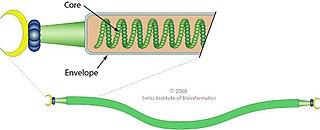
Potyviridae is a family of positive-strand RNA viruses that encompasses more than 30% of known plant viruses, many of which are of great agricultural significance. The family has 12 genera and 235 species, three of which are unassigned to a genus.
Furovirus is a genus of viruses, in the family Virgaviridae. Graminae, winter wheat, wheat, triticale, oat, sorghum bicolor, and plants serve as natural hosts. There are six species in this genus. Diseases associated with this genus include: (SBWMV): green and yellow mosaic.

Benyvirus is a genus of viruses, in the family Benyviridae. Plants serve as natural hosts. There are four species in this genus. Diseases associated with this genus include: BNYVV: rhizomania.
Icerudivirus is a genus of viruses in the family Rudiviridae. These viruses are non-enveloped, stiff-rod-shaped viruses with linear dsDNA genomes, that infect hyperthermophilic archaea of the species Sulfolobus islandicus. There are three species in the genus.

Lipothrixviridae is a family of viruses in the order Ligamenvirales. Thermophilic archaea in the phylum Thermoproteota serve as natural hosts. There are 11 species in this family, assigned to 4 genera.
Hordeivirus is a genus of viruses, in the family Virgaviridae. Plants serve as natural hosts. There are four species in this genus.
Pecluvirus is a genus of viruses, in the family Virgaviridae. Cereal crops and graminaceous weeds serve as natural hosts. There are two species in this genus. Diseases associated with this genus include: (SBWMV): green and yellow mosaic. The name of the genus is derived from Peanut clump virus: Peanut clump virus, giving rise to Pecluvirus.
Pomovirus is a genus of viruses, in the family Virgaviridae. Plants and dicotyledons serve as natural hosts. There are five species in this genus. Diseases associated with this genus include: dwarfing of shoots (mop-top) and potato spraing disease. The name of the genus is derived from Potato mop-top virus, Potato mop-top virus, giving rise to Pomovirus.
Fuselloviridae is a family of viruses. Sulfolobus species, specifically shibatae, solfataricus, and islandicus, serve as natural hosts. There are two genera and nine species in the family. The Fuselloviridae are ubiquitous in high-temperature (≥70 °C), acidic hot springs around the world.
Guttaviridae is a family of viruses. Archaea serve as natural hosts. There are two genera in this family, containing one species each. The name is derived from the Latin gutta, meaning 'droplet'.
Gammaflexiviridae is a family of viruses in the order Tymovirales. Fungi serve as natural hosts. There is only one genus in the family, Mycoflexivirus, which has one species: Botrytis virus F.

Bottigliavirus is the only genus in the family Ampullaviridae and contains 3 species. Ampullaviridae infect archaea of the genus Acidianus. The name of the family and genus is derived from the Latin word for bottle, ampulla, due to the virions having the shape of a bottle. The family was first described during an investigation of the microbial flora of hot springs in Italy.

Virgaviridae is a family of positive-strand RNA viruses. Plants serve as natural hosts. The name of the family is derived from the Latin word virga (rod), as all viruses in this family are rod-shaped. There are currently 59 species in this family, divided among seven genera.
Betalipothrixvirus is a genus of viruses in the family Lipothrixviridae. Archaea serve as natural hosts. The genus contains six species.
Deltalipothrixvirus is a genus of viruses in the family Lipothrixviridae. Archaea acidianus serve as natural hosts. Two species are assigned to the genus.

Captovirus is a genus of viruses in the family Ungulaviridae. Archaea acidianus serve as natural hosts. There is only one species in this genus: Captovirus AFV1, also known as Acidianus filamentous virus 1.
Sulfolobus islandicus rod-shaped virus 1 (SIRV1) is a virus in the order Ligamenvirales. Its only known host is the Archaean Sulfolobus islandicus. The species was first documented from a hot spring sample in Yellowstone National Park.
Stygiolobus rod-shaped virus (SRV), scientific name Azorudivirus SRV, is an archaeal virus and the sole species in the genus Azorudivirus. Its only known host is Stygiolobus archaea.

Adnaviria is a realm of viruses that includes archaeal viruses that have a filamentous virion and a linear, double-stranded DNA genome. The genome exists in A-form (A-DNA) and encodes a dimeric major capsid protein (MCP) that contains the SIRV2 fold, a type of alpha-helix bundle containing four helices. The virion consists of the genome encased in capsid proteins to form a helical nucleoprotein complex. For some viruses, this helix is surrounded by a lipid membrane called an envelope. Some contain an additional protein layer between the nucleoprotein helix and the envelope. Complete virions are long and thin and may be flexible or a stiff like a rod.
Naldaviricetes is a class of viruses, which infect arthropods. Members of Naldaviricetes are characterized by large enveloped rod-shaped virions, circular double-stranded DNA genomes, and replication in the nucleus of the host cell. All of them share a set of unique genes not found in other viruses, which include the presence of multiple interspersed direct repeats, various subunits of DNA polymerase and RNA polymerase, four late expression factor genes, and infectivity factor genes suggesting a common host entry mechanism.





